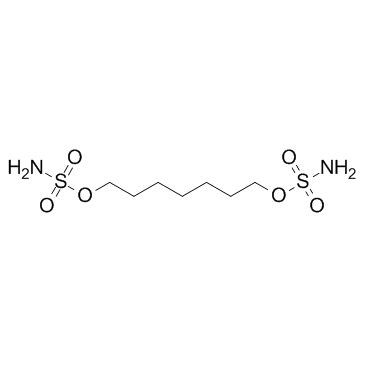96892-57-8
| Name | 7-sulfamoyloxyheptyl sulfamate |
|---|---|
| Synonyms |
Hepsulfam
heptane-1,7-diyl disulfamate Sulfamic acid 7-sulfamoyloxy-heptyl ester 1,7-Heptanediol disulfamate Sulfamic acid,1,7-heptanediyl ester |
| Description | Hepsulfam (NCI 329680; ZINC01574758) is a anticancer agent that shows excellent antileukemic activity with an median IC50 of 0.91 μg/mL in a panel of different tumors. |
|---|---|
| Related Catalog | |
| Target |
IC50: 0.91 μg/mL (Tumors)[1] |
| In Vitro | At a concentration of 1.0 μg/mL, hepsulfam is active in eight of 37 tumors (22%) in the clonogenic assay. Hepsulfam demonstrates a clear in vitro toxicity to human bone marrow cells (CFU-GM) from healthy donors. Evaluation of equitoxic concentrations in vitro reveals a higher activity of hepsulfam, especially in non-small cell lung cancer[1]. Hepsulfam is more toxic to L1210 leukemia cells than is busulfan, its structural homologue . Consistent with the difference in toxicity, hepsulfam induces DNA interstrand cross-links in L1210 mouse leukemia cells, whereas busulfan does not. Hepsulfam is more cytotoxic to two human leukemia cell lines (111-60 and K562) and to two human colon carcinoma cell lines (BE and HT-29) than is busulfan. As in 11210 cells, hepsulfam induces a higher level of DNA interstrand cross-links than busulfan. Hepsulfam is also more cytotoxic to the human leukemia cell lines when the concentrations are reduced 10-fold and the duration of drug exposure is increased to 12 h[2]. |
| In Vivo | Hepsulfam demonstrates superior in vivo activity in a large cell lung cancer xenograft and a gastric carcinoma model. The preclinical activity of hepsulfam suggests a possible role of this compound in the treatment of solid human malignancies. However, the increased bone marrow toxicity of hepsulfam as compared with busulfan might be critical for further clinical application[1]. |
| Cell Assay | HL-60 or K562 leukemia cells (1x106/mL) are treated with various concentrations of hepsulfam for 2, 3,6, 9, or 12 h at 37°C. The concentration of DMSO in either control or treated cells is never greater than 2% (v/v). Following drug exposure, the cells are ished by centrifugation in RPMI 1640 medium and resuspended in fresh medium. Following this ish, cells are either assayed immediately for DNA damage by alkaline elution or incubated at 37°C for various periods before assay. BE and HT-29 human colon carcinoma cells are processed for alkaline elution analysis or cytotoxicity assays[2]. |
| References |
| Density | 1.407g/cm3 |
|---|---|
| Boiling Point | 478.2ºC at 760 mmHg |
| Molecular Formula | C7H18N2O6S2 |
| Molecular Weight | 290.35800 |
| Flash Point | 243ºC |
| Exact Mass | 290.06100 |
| PSA | 155.54000 |
| LogP | 2.93930 |
| Index of Refraction | 1.521 |
| Storage condition | 2-8℃ |
CHEMICAL IDENTIFICATION
HEALTH HAZARD DATAACUTE TOXICITY DATA
MUTATION DATA
|
